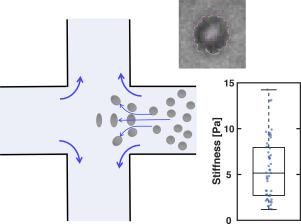Biochimica et Biophysica Acta (BBA) - General Subjects ( IF 3 ) Pub Date : 2020-06-06 , DOI: 10.1016/j.bbagen.2020.129657 Cristina Rodriguez-Quijada 1 , Joanna B Dahl 1

|
Background
Cells exchange information by secreting micro and nanosized extracellular vesicles (EVs), ranging from exosomes (30–100 nm) to apoptotic bodies (ABs, 1–5 μm). There is still much to understand about fundamental EV biological, physical, and chemical properties before clinical applications can be developed. EV mechanical properties have only been measured with atomic force microscopy (AFM) with its problematic adhesion and hard substrate effects. To understand EV mechanical behavior in less extreme mechanical conditions relevant to blood flow and many soft tissue environments, a non-contact measurement technique is needed.
Methods
We measured the mechanical properties of single microscale ABs derived from human blood plasma using non-contact microfluidics. EVs were gently stretched in extensional flow, similar to a traditional tensile test, and a linear mechanical model was applied to estimate mechanical stiffnesses from the observed stretching.
Results
The effective shear elastic modulus of ABs in non-contact flow conditions is approximately 5.6 ± 0.5 Pa, 7 orders of magnitude lower than previously reported AFM-measured biological exosome stiffnesses and 200 times smaller than suspended cells.
Conclusions
Apoptotic bodies are very soft in fluid environments and exhibit lower effective stiffnesses than suspended cells. By measuring ABs in a natural fluid environment and low-force regime without hard probes and surfaces, we achieved closer agreement with linear mechanical theory and therefore more accurate stiffness measurements.
General significance
AFM manufacturers and users should consider implementing new mechanical models to interpret AFM force indentation curves so that accurate extracellular vesicle mechanical properties can be extracted.
中文翻译:

单个凋亡小体的非接触式微流体力学性能测量。
背景
细胞通过分泌微小的和纳米级的细胞外囊泡(EV)交换信息,囊泡的大小从外泌体(30–100 nm)到凋亡小体(AB,1-5μm)。在开发临床应用之前,关于电动汽车的基本生物学,物理和化学特性仍有很多了解。EV的机械性能仅通过原子力显微镜(AFM)进行了测量,因为其附着力和基材效果不佳。为了了解在与血流和许多软组织环境有关的不太极端的机械条件下的EV机械行为,需要一种非接触式测量技术。
方法
我们使用非接触式微流体技术测量了源自人血浆的单个微型AB的机械性能。与传统的拉伸试验类似,电动汽车在拉伸流中缓慢拉伸,然后应用线性力学模型从观察到的拉伸中估算机械刚度。
结果
在非接触流动条件下,ABs的有效剪切弹性模量约为5.6±0.5 Pa,比以前报道的AFM测量的生物外来体硬度低7个数量级,比悬浮细胞小200倍。
结论
凋亡小体在流体环境中非常柔软,并且具有比悬浮细胞低的有效刚度。通过在自然流体环境和低力条件下测量AB,而无需使用硬探头和表面,我们与线性力学理论取得了更紧密的一致,因此更精确地测量了刚度。
一般意义
AFM制造商和用户应考虑实施新的力学模型来解释AFM力的压痕曲线,以便可以提取出准确的细胞外囊泡力学特性。


























 京公网安备 11010802027423号
京公网安备 11010802027423号